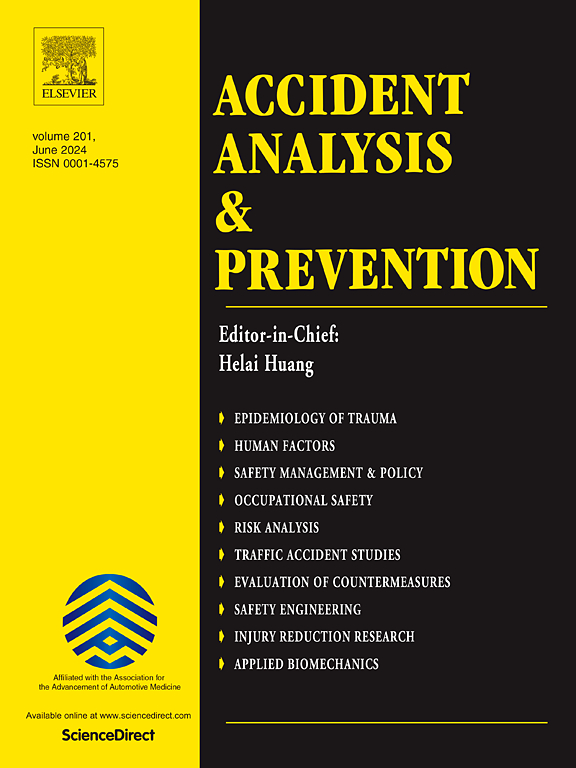数字时代骑自行车者的安全:先进预警技术综述
IF 5.7
1区 工程技术
Q1 ERGONOMICS
引用次数: 0
摘要
改善骑车者的安全至关重要,因为骑车者被认为是弱势的道路使用者。实施一个警告系统,提醒骑自行车的人注意附近的危险,是提高他们安全的有效方法。然而,文献需要一个全面和详细的审查骑自行车的警告系统。本文根据系统评价和荟萃分析(PRISMA)指南的首选报告项目(n = 78),对现有的关于提高骑自行车者安全的预警技术和系统的研究进行了系统回顾。根据审查,发现最常用的自行车警告技术是带有人工智能(AI)的摄像头、超声波传感器、激光雷达和雷达。此外,通过使用警告系统进行自行车实验的研究得出了一些见解:(1)大多数骑行者对预警技术/系统的反应是积极的;(2)大多数骑行者更喜欢听觉信号而不是视觉或触觉信号作为预警方式;(3)预警技术/系统会影响骑行者在紧急情况下的一些行为,如提前刹车、更快的反应、注意力更集中、保持更安全的距离和暂时减速;(4)只有两项研究试图探讨预警系统如何影响碰撞风险。未来的研究应该把重点放在开发紧凑、轻便和负担得起的预警系统上。还需要更多的研究来证明骑车人警告系统对骑车人碰撞风险的影响。这篇综述指出了当前文献中的空白,并为未来的研究提供了坚实的基础,以提高骑自行车者的安全。本文章由计算机程序翻译,如有差异,请以英文原文为准。
Cyclist safety in the digital age: A review of advanced warning technologies
Improving the safety of cyclists, who are considered vulnerable road users, is essential. Implementing a warning system that alerts cyclists to nearby hazards is an effective method to improve their safety. Nevertheless, the literature needs a comprehensive and detailed review of cyclist warning systems. This paper presents a systematic review of existing studies about warning technologies and systems developed to improve cyclist safety, following Preferred Reporting Items for Systematic Reviews and Meta-Analyses (PRISMA) guidelines (n = 78). Based on the review, it was found that the most used cyclist warning technologies were cameras with artificial intelligence (AI), ultrasonic sensors, lidar, and radar. Furthermore, there were some insights from the studies that conducted cycling experiments with the use of a warning system: (1) most participating cyclists responded positively to the warning technologies/systems, (2) most cyclists preferred auditory signals over visual or haptic signals as warning modalities, (3) warning technologies/systems influenced some cyclists’ behaviour during critical situations, such as early braking, faster reactions, increased focus, maintaining a safer distance, and temporarily reducing speed, and (4) only two studies tried to explore how warning systems affect crash risk. Future research should focus on developing warning systems that are compact, lightweight, and affordable. More studies are also needed to demonstrate the impact of the cyclist warning system on cyclists’ crash risk. This review identifies gaps in the current literature and offers a solid foundation for future studies to enhance cyclist safety.
求助全文
通过发布文献求助,成功后即可免费获取论文全文。
去求助
来源期刊

Accident; analysis and prevention
Multiple-
CiteScore
11.90
自引率
16.90%
发文量
264
审稿时长
48 days
期刊介绍:
Accident Analysis & Prevention provides wide coverage of the general areas relating to accidental injury and damage, including the pre-injury and immediate post-injury phases. Published papers deal with medical, legal, economic, educational, behavioral, theoretical or empirical aspects of transportation accidents, as well as with accidents at other sites. Selected topics within the scope of the Journal may include: studies of human, environmental and vehicular factors influencing the occurrence, type and severity of accidents and injury; the design, implementation and evaluation of countermeasures; biomechanics of impact and human tolerance limits to injury; modelling and statistical analysis of accident data; policy, planning and decision-making in safety.
 求助内容:
求助内容: 应助结果提醒方式:
应助结果提醒方式:


